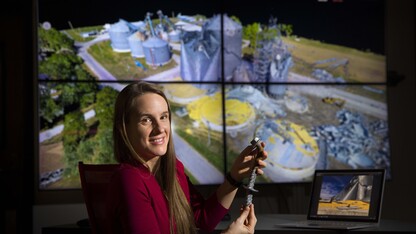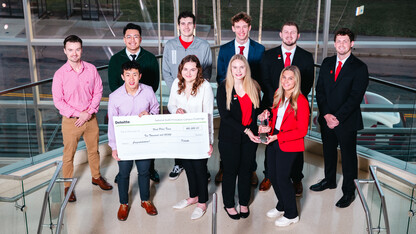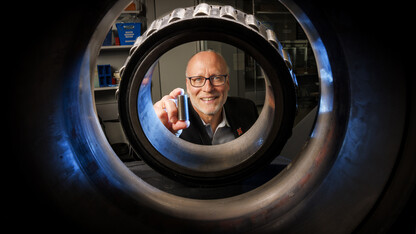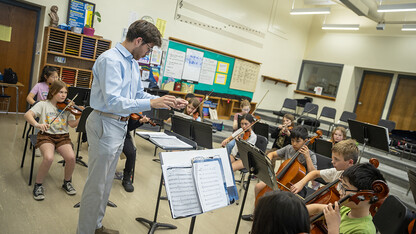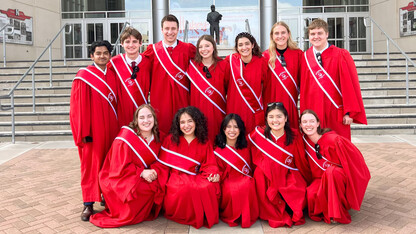· 6 min read
Achievements | Kunc headed to Japan for international printmaking conference
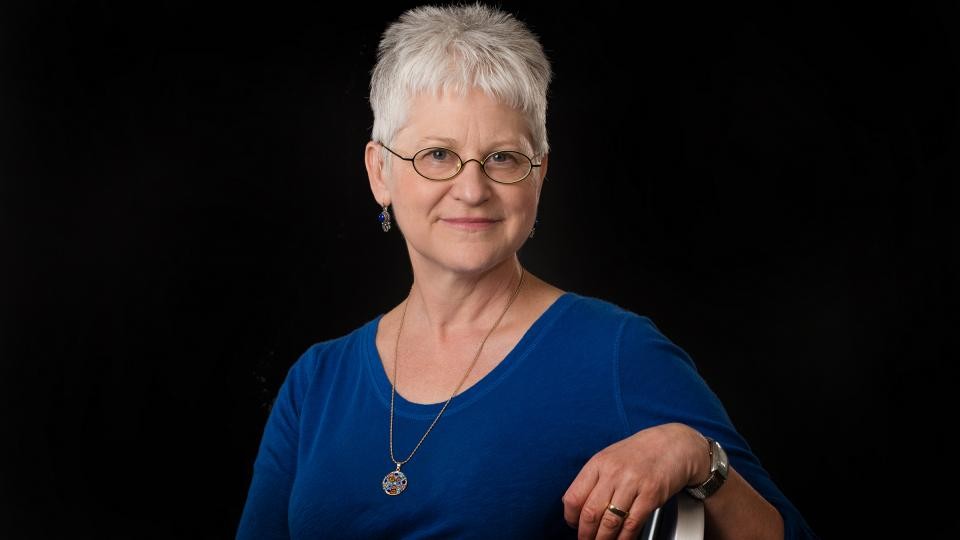
Karen Kunc, Willa Cather Professor of Art, will travel to Japan in September to attend the 2014 International Mokuhanga Conference at Tokyo University of the Arts. She is the chair of the conference’s international board.
Mokuhanga is the art technique of traditional Japanese woodblock. The art form became popular during the Edo period (1603-1867) when complex multi-color prints were made by publishing houses in Japan. The works were designed by the leading artists of the time.
“This term has become more prevalent and used even in the West to indicate prints done in the Japanese water-based method,” Kunc said. “So the inks are watercolor and are applied by a brush and not with a roller. The printing is done by hand with the bamboo baren, instead of using a press for the transfer of oil-based ink typical in Western methods.”
Kunc’s first experience with Mokuhanga was in 2001 when she completed a residency in Japan for six weeks that specialized in Mokuhanga and was run by Nagasawa Art Park.
“It was a wonderful residency to become immersed into the countryside village and small town on the island of Awaji,” Kunc said. “And yes, we were meant to adapt to all of these processes, working on our knees on the tatami mats, and also interacting with the small community that was there. It was an amazing experience.”
Kunc said the Mokuhanga process creates a different look than her oil-based woodcuts.
“I think the Mokuhanga method has a softer quality,” she said. “The ink actually does look a little watery. It interacts with the wood differently. I like it because I can contrast those effects with the oil-based effects, and those two different print qualities and textures — inside and onto the paper — can speak to each other. It feels like I am speaking a greater range of vocabulary with the combination of both woodcut approaches.”
Kunc joined the International Board about a year before the first International Mokuhanga Conference in 2011.
“The Japanese organizers were interested in having a global presence on their international board to continue the network that had been started through their residency program for international artists. Artists from all over the world have been learning the Mokuhanga process for more than 15 years through the Nagasawa Art Park, and now at the new IM-Lab site based at the foot of Mt. Fuji,” Kunc said.
This year’s conference will have about 200 participants from more than 15 countries around the world, including Australia, the United Kingdom, Canada, Poland, Netherlands, China, Italy, the U.S. and Finland.
Exhibitions will include an open Mokuhanga Competition Exhibition, featuring more than 150 contemporary artists’ works. In addition, Tokyo University of the Arts is also organizing an historical exhibition from the collection of the Tokyo Museum of Art.
Kunc will have some of her work displayed in a juried International Print Book Exhibition, as well as an exhibition that the board was invited to participate in alongside the competition exhibition. She will also participate in an open portfolio session.
In addition, the conference will include demonstrations and panel discussions that include new research about the historical facets of the Mokuhanga printmaking and how to keep the process alive today.
“One interesting opportunity is for the printmakers to meet with the makers of the traditional papers and tools,” Kunc said. “Again, one of our interests is how do you preserve this craft that they have passed down in family businesses, father to son, very small, traditional craft cultures. It needs to be preserved, but they need people who want to use their materials for it to have a market. There’s a natural relationship between the two that doesn’t often have a chance to come together.”
Kunc said there is great value in preserving the Mokuhanga process.
“All hand printmaking is somewhat anachronistic. We’re still interested in making things by hand,” Kunc said. “There’s a really important value in that experience. There’s a mind-body flow with creative work that way, and in many ways, I want to be an advocate for that.”
She views her work with the conference as important in spreading the knowledge and awareness of this printmaking process.
“The more we can expand our knowledge and bring awareness of the variety of visual effects and how we respond to these qualities, it increases our understanding and the value of this medium,” Kunc said. “Japanese prints are beloved around the world. Each month there is an international showing of Japanese prints somewhere in the world. They’re in collections everywhere. We have to keep it as a living art, not a museum artifact.”
For more information, go to http://go.unl.edu/imhd.
Other recent awards and honors earned by the UNL community include:
Faculty
• Rick Endacott and Steve Kolbe received a Silver Screen Award from the U.S. International Film and Video Festival for their instructional video “StageCraft: Building Flats and Platforms.” The video provides everything the inexperienced set-builder needs to know to go from a bare room to a professional stage.
Endacott is an associate professor of film. Kolbe is an assistant professor of film.
The festival offers five mini-competitions in one by recognizing outstanding corporate, education, entertainment, documentary and student productions.
For more information, go to http://go.unl.edu/p39a.
• Rich Leiter, professor of law, was recognized among the 2014 “Fastcase 50” by the legal publisher Fastcase. The annual awards highlight entrepreneurs, innovators and trailblazers who have charted a new course for the delivery of legal services.
Leiter received the award for his pioneering work into citation analysis tools. He researched whether a superset of cases have been cited frequently by law review articles, and whether someone could use the citation relationships to give special weight to certain opinions in legal research.
Leiter, who is also director of the Schmid Law Library in the University of Nebraska’s College of Law, has been co-host of the “Law Librarian Conversations” podcast for almost 30 years. His book, “National Survey of State Laws,” is a valued industry resource, comparing state laws across a variety of topics.
For more information, go to http://go.unl.edu/a7u9.
Students
• Seth Gurley, a senior agronomy and integrated crop management major, was named the 2014 Outstanding West Central Division Intern Award winner by Helena Chemical Co. He was selected from a group of 67 Midwest interns from 22 universities for his performance during a summer internship with Helena Chemical. He served in a sales and marketing post with the company branch in Osmond.
Colleges
• The College of Law was ranked No. 3 in a top 25 list of the best online Master of Business Administration in international business degree programs. The list was compiled by TheBestSchools.org, an independent organization that serves as an information resource for students seeking degrees in higher education.
The degree program rankings were based on academic success, range of available classes, faculty strength, rankings and reputation.
This column is a regular feature of UNL Today. Faculty, staff and students can submit their achievements to be considered for this column via email to achievements@unl.edu. For more information, call 402-472-8515.
